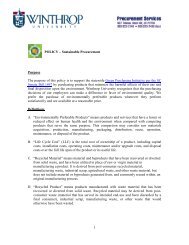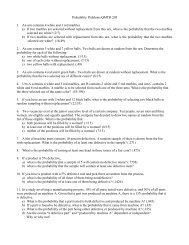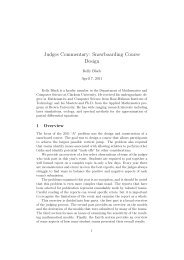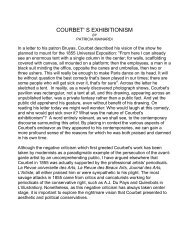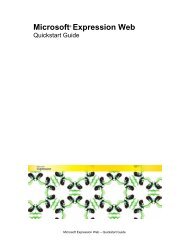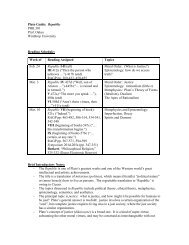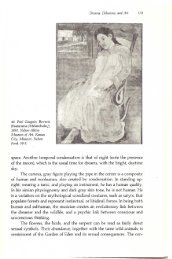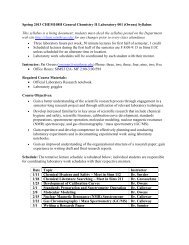Making the Most of Short-Term Immersion - NAFSA
Making the Most of Short-Term Immersion - NAFSA
Making the Most of Short-Term Immersion - NAFSA
You also want an ePaper? Increase the reach of your titles
YUMPU automatically turns print PDFs into web optimized ePapers that Google loves.
education<br />
Abroad<br />
By Ernesto Guerrero<br />
<strong>Making</strong> <strong>the</strong> <strong>Most</strong> <strong>of</strong> <strong>Short</strong>-<strong>Term</strong> <strong>Immersion</strong><br />
International Educator J UL+AU G.05<br />
What happens<br />
when a<br />
location has<br />
an excellent<br />
infrastructure<br />
that allows for<br />
great ease <strong>of</strong><br />
administration<br />
and yet,<br />
at <strong>the</strong> same<br />
time, presents<br />
unexpected<br />
yet distinct<br />
obstacles with<br />
regard to immersion<br />
in <strong>the</strong><br />
local society<br />
and culture?<br />
Study abroad programs try to accomplish many different goals. Often<br />
near <strong>the</strong> top <strong>of</strong> <strong>the</strong> list is immersing students in <strong>the</strong> culture and society <strong>of</strong> <strong>the</strong> host country<br />
and city. The location (<strong>the</strong> college or university) being visited <strong>of</strong>ten determines to a great<br />
extent <strong>the</strong> manner and <strong>the</strong> extent <strong>of</strong> this immersion. Unfortunately, <strong>the</strong> instructional outcomes<br />
both inside and outside <strong>of</strong> <strong>the</strong> classroom are not <strong>the</strong> only factors university administrators<br />
have to consider when deciding to stay in a given location over time. Frequently<br />
<strong>the</strong>re are logistical factors to consider such as <strong>the</strong> condition <strong>of</strong> instructional facilities, quality<br />
<strong>of</strong> <strong>the</strong> school’s administration, instructors, etc. So what happens when a location has an<br />
excellent infrastructure that allows for great ease <strong>of</strong> administration and yet, at <strong>the</strong> same<br />
time, presents unexpected yet distinct obstacles with regard to immersion in <strong>the</strong> local<br />
society and culture?<br />
This is <strong>the</strong> situation faced by <strong>the</strong> summer study<br />
abroad program in Puebla, Mexico, administered by<br />
<strong>the</strong> Department <strong>of</strong> Spanish and Portuguese at <strong>the</strong><br />
University <strong>of</strong> California-Los Angeles (UCLA). The<br />
four-week program is housed at <strong>the</strong> Universidad de<br />
las Américas (UDLA) in Puebla, one <strong>of</strong> <strong>the</strong> premiere<br />
private universities in Mexico and provides all <strong>of</strong> <strong>the</strong><br />
most modern facilities and amenities. However, because<br />
<strong>of</strong> <strong>the</strong> location, nature <strong>of</strong> <strong>the</strong> university, and<br />
length <strong>of</strong> <strong>the</strong> program, a question arises as to what<br />
kind <strong>of</strong> study abroad experience <strong>the</strong> students are actually<br />
getting. Are <strong>the</strong> students truly being exposed to<br />
<strong>the</strong> country and city being visited or are <strong>the</strong>y simply<br />
taking UCLA courses at a foreign university without<br />
any integration into <strong>the</strong> local context?<br />
On <strong>the</strong> Surface<br />
UDLA is located just outside <strong>the</strong> city <strong>of</strong> Puebla, about<br />
a 90-minute drive from Mexico City, in <strong>the</strong> smaller<br />
town <strong>of</strong> Cholula, which, in pre-Columbian times, was<br />
a bustling city in its own right. Evidence <strong>of</strong> this can<br />
still be seen in <strong>the</strong> impressive archeological remains<br />
that are located within a moderate walking distance<br />
from <strong>the</strong> campus. Both Cholula and Puebla are beautiful<br />
colonial jewels that <strong>of</strong>fer students a glimpse <strong>of</strong><br />
everyday Mexican life in small and moderate-size<br />
cities, away from <strong>the</strong> large cities and tourist meccas<br />
that may be <strong>the</strong> only exposure to Mexico prospective<br />
students <strong>of</strong> <strong>the</strong> program have had.<br />
This ideal location for UDLA is fur<strong>the</strong>r enhanced<br />
by <strong>the</strong> campus itself. Contemporary and colonial style<br />
architecture share space on <strong>the</strong> campus and give it a<br />
Alley <strong>of</strong><br />
<strong>the</strong> Frogs in<br />
Puebla,<br />
Mexico<br />
42
istockphoto<br />
modern yet distinctly classic Mexican appearance. These buildings<br />
house up-to-date equipment and facilities that would be found at<br />
just about any comparably sized campus in <strong>the</strong> United States. In<br />
addition to <strong>the</strong>se academic resources, <strong>the</strong> campus has o<strong>the</strong>r amenities<br />
that make it very similar to a U.S. liberal arts campus. There is<br />
a swimming pool located near <strong>the</strong> athletic field where <strong>the</strong> school’s<br />
football team practices. That would be <strong>the</strong> American football team<br />
(<strong>the</strong>re is also a school soccer team). All <strong>of</strong> this is enclosed by a fence<br />
with various gates around <strong>the</strong> perimeter. Security guards staff <strong>the</strong>se<br />
gates 24 hours a day. At night anyone trying to get into <strong>the</strong> campus<br />
has to present an ID or some type <strong>of</strong> pro<strong>of</strong> that justifies <strong>the</strong>ir purpose<br />
on <strong>the</strong> campus.<br />
Similar to <strong>the</strong> modernity <strong>of</strong> <strong>the</strong> facilities on campus, <strong>the</strong> administrative<br />
structure in <strong>the</strong> academic units are first-rate and are well<br />
equipped to accommodate international summer study abroad programs.<br />
Administrators work closely with representatives and faculty<br />
from <strong>the</strong> home campuses to create and manage programs that are<br />
tailored to <strong>the</strong>ir specific needs.<br />
A Closer Look<br />
From <strong>the</strong> description above, it would seem like UDLA provides <strong>the</strong><br />
ideal situation for an American university or college that wants to<br />
establish a travel study program in Mexico. In many ways it does.<br />
However if we revisit <strong>the</strong> goals <strong>of</strong> study abroad programs mentioned<br />
earlier we remember that for most, immersing students in<br />
<strong>the</strong> culture and society <strong>of</strong> <strong>the</strong> host country and city is usually <strong>of</strong><br />
primary importance. With regard to this goal, programs like <strong>the</strong><br />
one at UDLA may not always get <strong>the</strong> job done.<br />
Ironically, <strong>the</strong> very same things that make it so appealing make<br />
it that much harder for students to engage in activities in which<br />
<strong>the</strong>y can become immersed in <strong>the</strong> local culture. UDLA can afford<br />
to have excellent administration, facilities, and amenities because<br />
it is a prestigious private institution. Many wealthy and prominent<br />
families from Mexico City and <strong>the</strong> surrounding area send <strong>the</strong>ir<br />
children here. Such an institution has to provide <strong>the</strong> best facilities<br />
for its students. This includes a secure and safe environment.<br />
Consequently <strong>the</strong> university becomes an island unto itself. Students<br />
rarely have to leave if <strong>the</strong>y do not want to because nearly all <strong>of</strong> <strong>the</strong>ir<br />
needs can be met on campus. The result is a top-rate and well managed<br />
university with abundant resources that provides students just<br />
about everything <strong>the</strong>y need. This may be exactly what <strong>the</strong> Mexican<br />
students and <strong>the</strong>ir families want but it makes it harder for a summer<br />
study abroad program to accomplish its goals.<br />
<strong>Short</strong>-term summer study abroad programs such UCLA’s have<br />
to face <strong>the</strong>se obstacles <strong>of</strong> isolation in addition to a few o<strong>the</strong>rs if <strong>the</strong>y<br />
want to give students a rich cultural experience. The fact that it is in<br />
<strong>the</strong> summer already reduces <strong>the</strong> number <strong>of</strong> Mexican students that<br />
U.S. students can interact with. Granted, <strong>the</strong> lack <strong>of</strong> local students<br />
is a problem encountered by any summer study abroad program;<br />
however, when added to <strong>the</strong> obstacles already mentioned, it makes<br />
cultural immersion that much more difficult. Ano<strong>the</strong>r issue that<br />
all study abroad programs have to contend with is <strong>the</strong> tendency<br />
for students from a given program to congregate with each o<strong>the</strong>r<br />
and not interact with o<strong>the</strong>r students or locals. This is <strong>of</strong> particular<br />
importance if students are trying to learn a foreign language. The<br />
problem is influenced by <strong>the</strong> living conditions. For example, UCLA’s<br />
students live in residence halls, all toge<strong>the</strong>r in <strong>the</strong> same floors or in<br />
adjoining buildings.<br />
Curriculum Concerns<br />
A program’s curriculum is also a significant factor in <strong>the</strong> students’<br />
ability to immerse in <strong>the</strong> local culture. For UCLA’s Puebla program,<br />
students elect one <strong>of</strong> three tracks: elementary, intermediate,<br />
or advanced. In <strong>the</strong> elementary track students complete <strong>the</strong><br />
last two quarters (UCLA is on <strong>the</strong> quarter system) <strong>of</strong> <strong>the</strong> first<br />
year <strong>of</strong> college level Spanish, a culture seminar, and <strong>the</strong>n have <strong>the</strong><br />
option to take an additional independent study course that <strong>the</strong>y<br />
start <strong>the</strong>re but have <strong>the</strong> rest <strong>of</strong> <strong>the</strong> summer to complete. The intermediate<br />
track is <strong>the</strong> same except that <strong>the</strong>re students complete<br />
<strong>the</strong> second year <strong>of</strong> Spanish. In <strong>the</strong> advanced track students take<br />
a composition course and a culture course, again with <strong>the</strong> option<br />
<strong>of</strong> <strong>the</strong> independent study course.<br />
J UL+AU G.05 International Educator<br />
43
International Educator J UL+AU G.05<br />
The purpose <strong>of</strong> a U.S. school creating a study abroad<br />
program is not to replicate an existing program on foreign<br />
soil but ra<strong>the</strong>r to create a program that accomplishes certain<br />
academic goals by incorporating <strong>the</strong> unique cocurricular<br />
activities available when studying in a foreign country.<br />
The intensive nature <strong>of</strong> summer programs<br />
such as this one can make cultural<br />
immersion even more difficult. For example,<br />
<strong>the</strong> accelerated curriculum in Puebla means<br />
that students are taking a quarter’s worth <strong>of</strong><br />
work (10 weeks) in a reduced time frame (4<br />
weeks). This also means that students have<br />
to study more per day than <strong>the</strong>y would<br />
o<strong>the</strong>rwise in a regular quarter. Taking all <strong>of</strong><br />
<strong>the</strong>se factors into account (<strong>the</strong> facilities on<br />
campus, <strong>the</strong> security, <strong>the</strong> conditions specific<br />
to summer) students have to make a concerted<br />
effort to get significant exposure to<br />
<strong>the</strong> local culture and community. A typical<br />
day might consist <strong>of</strong> <strong>the</strong> students getting up,<br />
having breakfast with each o<strong>the</strong>r in <strong>the</strong> cafeteria,<br />
going to <strong>the</strong>ir classes, going to dinner<br />
toge<strong>the</strong>r in <strong>the</strong> cafeteria, studying toge<strong>the</strong>r,<br />
and <strong>the</strong>n going to bed. The weekends <strong>of</strong>fer<br />
greater opportunities for contact with <strong>the</strong><br />
outside but even <strong>the</strong>n it is not as simple as<br />
walking to town. Cholula, <strong>the</strong> closest town,<br />
is not far but it is at least a 15-20 minute<br />
walk although students can get <strong>the</strong>re with<br />
a short bus ride. Puebla, <strong>the</strong> larger city, is<br />
a 20-minute bus ride or a 15-minute taxi<br />
ride away. The point here is that students<br />
can get to <strong>the</strong>se places fairly easily but with<br />
<strong>the</strong> campus providing so much and <strong>the</strong> students<br />
having a heavier study load, it is <strong>of</strong>ten<br />
very tempting for students to simply stay on<br />
campus. Even if students decided to go out<br />
to <strong>the</strong> city on <strong>the</strong> weekends, a month-long<br />
program allows for only four weekends <strong>of</strong><br />
this (three if you consider that much <strong>of</strong> <strong>the</strong><br />
last weekend is spent getting ready to go<br />
home).<br />
Time and Opportunity<br />
The resulting problem with this situation<br />
is two-fold, one clearer than <strong>the</strong> o<strong>the</strong>r. The<br />
more obvious problem is <strong>the</strong> lack <strong>of</strong> opportunities<br />
for interaction with <strong>the</strong> local population,<br />
be it students or residents. Such a<br />
condensed program not only has fewer opportunities<br />
for interaction but less time for<br />
interaction overall (four weeks). The not so<br />
obvious problem has to do with student perceptions<br />
about <strong>the</strong> society and culture that<br />
<strong>the</strong>y are visiting. Students are housed in an<br />
elite private institution that has all <strong>the</strong> comforts<br />
<strong>of</strong> home and that allows little access to<br />
<strong>the</strong> surrounding community. This could lead<br />
to students acquiring a skewed or at least inaccurate<br />
perception <strong>of</strong> life in Mexico as well<br />
as its culture. Therefore <strong>the</strong> reduced time<br />
and opportunities for interaction combine<br />
with <strong>the</strong> privileged status <strong>of</strong> <strong>the</strong> university<br />
to create an educational context that seriously<br />
jeopardizes one <strong>of</strong> <strong>the</strong> primary goals<br />
<strong>of</strong> any study abroad program: to immerse<br />
students in <strong>the</strong> culture and society <strong>of</strong> <strong>the</strong><br />
host country and city.<br />
The news, however, is not all bad. The<br />
UCLA Puebla program has found some<br />
ways to counteract <strong>the</strong> problem <strong>of</strong> inaccurate<br />
perceptions and to make up somewhat<br />
for <strong>the</strong> lack <strong>of</strong> interaction opportunities.<br />
These all revolve around <strong>the</strong> idea <strong>of</strong> maximizing<br />
<strong>the</strong> time outside <strong>of</strong> <strong>the</strong> classroom<br />
by planning organized cultural excursions<br />
that get students <strong>of</strong>f <strong>the</strong> campus and into<br />
<strong>the</strong> surrounding community.<br />
Three <strong>of</strong> <strong>the</strong> four weekends have planned<br />
excursions to Oaxaca, Mexico City, and<br />
Acapulco. Oaxaca is approximately a sixhour<br />
bus ride away but is well known for its<br />
rich culture and archeological ruins. When<br />
<strong>the</strong>y go to Mexico City students visit <strong>the</strong><br />
ruins <strong>of</strong> Teotihuacán just outside <strong>of</strong> <strong>the</strong> city<br />
before visiting <strong>the</strong> artist and bohemian section<br />
<strong>of</strong> <strong>the</strong> city, Coyoacán. The trip to Acapulco<br />
is more vacation-like in nature but it<br />
still provides students <strong>the</strong> opportunity to<br />
travel within <strong>the</strong> country and experience at<br />
least a couple <strong>of</strong> days outside <strong>the</strong> university.<br />
In addition to <strong>the</strong>se excursions, <strong>the</strong>re is also<br />
a planned trip to Puebla itself where many <strong>of</strong><br />
<strong>the</strong> culturally significant sites are visited.<br />
These outings go a long way towards<br />
giving <strong>the</strong> students a more substantial and<br />
balanced view <strong>of</strong> Mexico and <strong>the</strong> commu-<br />
44
nity <strong>of</strong> Puebla-Cholula. However, more can<br />
and should be done to maximize students’<br />
cultural immersion in a short four-week program<br />
like UCLA’s. Students can be required<br />
to interview one or more residents <strong>of</strong> <strong>the</strong> local<br />
community as part <strong>of</strong> an ethnographic assignment<br />
which can easily be incorporated into<br />
ei<strong>the</strong>r <strong>the</strong> language or culture courses <strong>the</strong>y<br />
are already taking. Mini internships <strong>of</strong> one<br />
or two hours a week can be organized that<br />
require students to work in a municipal <strong>of</strong>fice,<br />
museum, or archeological site. Such internships<br />
would provide valuable contact with<br />
members <strong>of</strong> <strong>the</strong> local community and could<br />
also be easily incorporated into <strong>the</strong> classes.<br />
Finally, an effort could be made to connect<br />
local artisans and artists with <strong>the</strong> students by<br />
organizing presentations ei<strong>the</strong>r on campus<br />
or in <strong>the</strong> community. In <strong>the</strong> case <strong>of</strong> Puebla<br />
and Cholula, those towns are well known for<br />
<strong>the</strong>ir pottery and confections so <strong>the</strong>re would<br />
be no lack <strong>of</strong> shops to arrange this. None <strong>of</strong><br />
<strong>the</strong>se suggestions are revolutionary but <strong>the</strong>y<br />
are examples <strong>of</strong> creative yet simple ways to<br />
give students more and better contact with<br />
<strong>the</strong> city and <strong>the</strong> country. Administrators and<br />
faculty <strong>of</strong> o<strong>the</strong>r programs can easily incorporate<br />
similar methods that suit <strong>the</strong> needs <strong>of</strong><br />
<strong>the</strong>ir particular program.<br />
Seeking a Balanced Approach<br />
Study abroad programs, whe<strong>the</strong>r <strong>the</strong>y are a<br />
year or a month long, have to work to strike<br />
a balance between <strong>the</strong> curricular and <strong>the</strong> cocurricular.<br />
The purpose <strong>of</strong> a U.S. school creating<br />
a study abroad program is not to replicate<br />
an existing program on foreign soil but ra<strong>the</strong>r<br />
to create a program that accomplishes certain<br />
academic goals by incorporating <strong>the</strong> unique<br />
cocurricular activities available when studying<br />
in a foreign country. This is obviously easier to<br />
accomplish if <strong>the</strong> host school has <strong>the</strong> administrative<br />
infrastructure to accommodate foreign<br />
programs. Fortunately for UCLA’s Department<br />
<strong>of</strong> Spanish and Portuguese, UDLA provides<br />
this but at <strong>the</strong> cost <strong>of</strong> a certain amount<br />
<strong>of</strong> isolation from <strong>the</strong> surrounding community.<br />
This problem is exacerbated by <strong>the</strong> nature <strong>of</strong><br />
summer study abroad programs that are more<br />
intensive and allow less time for cultural immersion.<br />
UCLA’s Puebla program has tried<br />
to address <strong>the</strong>se problems by incorporating<br />
cultural excursions into nearly every available<br />
weekend during <strong>the</strong> program. Excursions like<br />
<strong>the</strong>se as well as o<strong>the</strong>r efforts like internships<br />
and local engagement can be integrated into<br />
short-term summer study abroad programs<br />
such as this one so that students can have a<br />
rich cultural and academic experience. IE<br />
ERNESTO GUERRERO is a counselor for<br />
<strong>the</strong> College <strong>of</strong> Letters and Science at UCLA<br />
and for five years was <strong>the</strong> counselor for <strong>the</strong><br />
department <strong>of</strong> Spanish and Portuguese<br />
at UCLA. He is also currently a doctoral<br />
student in <strong>the</strong> UCLA Graduate School <strong>of</strong><br />
Education and Information Studies.<br />
J UL+AU G.05 International Educator<br />
45




